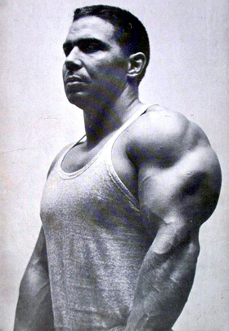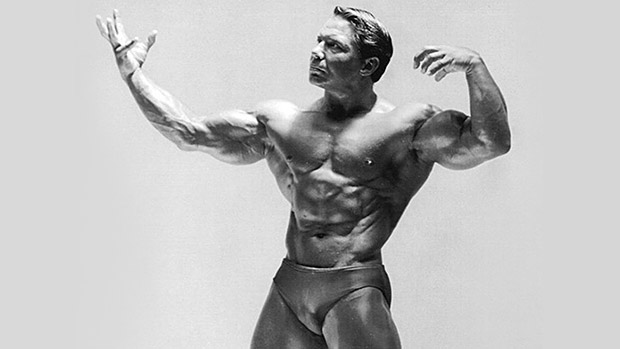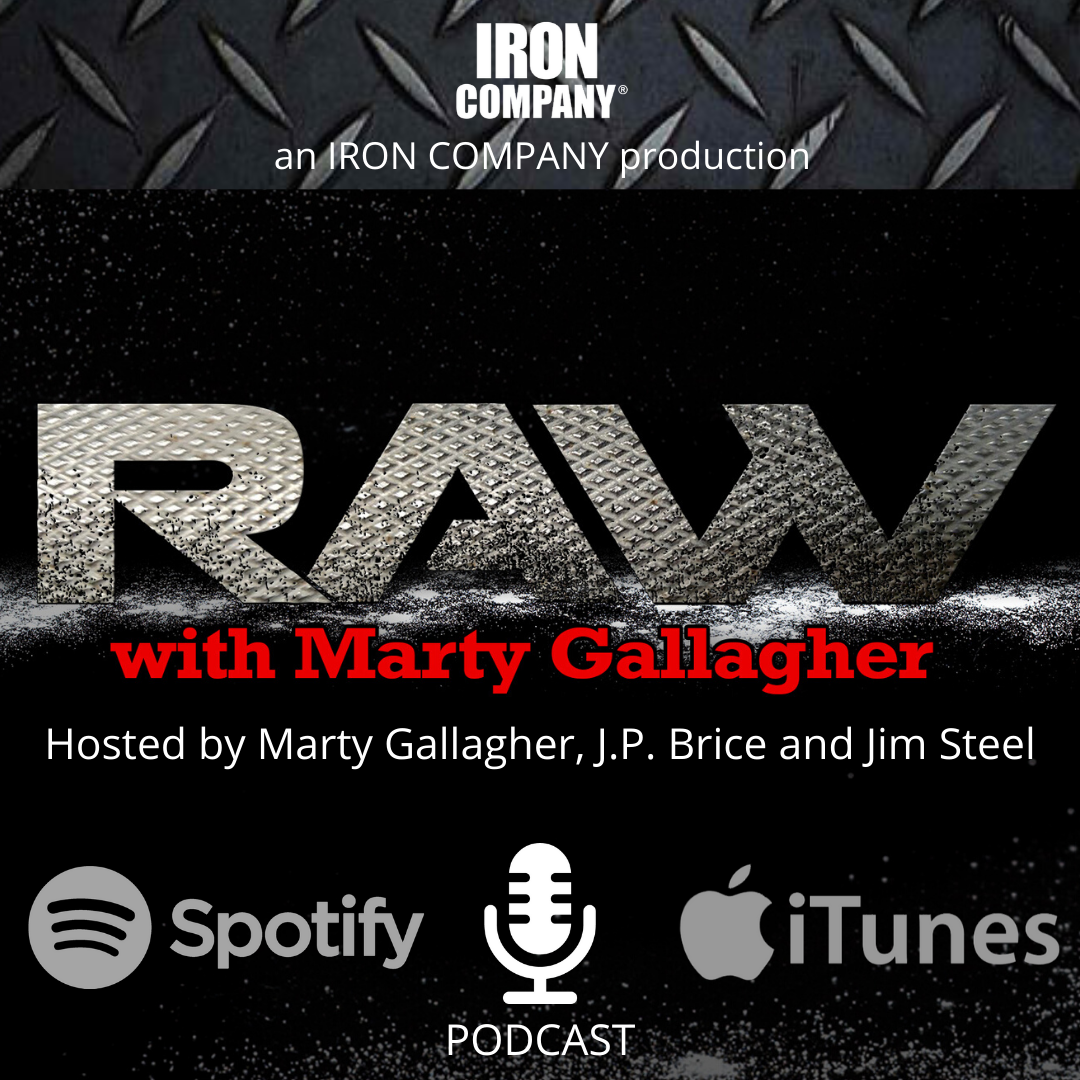
Triceps Power - Strengthen The Triceps To Push Up Pressing Poundage
Triceps - Give this muscle a seat at the table.
“My God son! What is this terrible swelling on the back of your arm?!” My old friend Bill Pearl (shown above) knew how to swell-up some triceps. In his gargantuan exercise encyclopedia, Keys to the Inner Universe, Bill identifies 100+ different types of triceps exercises.
One of the greatest compliments I ever received was inadvertent. I was undergoing a mandatory physical examination for football right before the start of summer two-a-day practices. The physician came in as I sat shirtless on the examining table. He looked at me and his eyes bugged out. “My God son!” he yelled as he rushed across the room and began prodding my right arm. “What is this terrible swelling on the back of your arm!” He was truly freaking out. Had he discovered patient zero in a suburban outbreak of elephantiasis? Had a horde of wasps attacked me? I pridefully flexed my triceps. He jumped backward like he’d been gut shot. “Wow!” I thought, I was over the moon, “Those weighted dips are really working!”
Triceps are the critical arm muscle. While its counterparts on the other side of the arm, the biceps, gets all the acclaim and attention, it’s the triceps that matter. Biceps are small, relatively insignificant muscles that get an undue amount of attention. The function of the biceps is to pull the fist in towards the shoulder, a fairly limited role. The triceps role is to extend the arm, to aide in pushing. Pushing outward occurs a lot in life.
The biceps are involved anytime a payload is pulled towards the body. There is not a lot of need for this function. Biceps activation occurs to a lesser degree when the arms are used in back work. Every back exercise has the athlete pull a payload in towards them (or pull it upward.) Rowing, seated rows, chins, under-grip narrow-grip lat pulldowns, 70-degree “Dorian” rows, all stimulate the biceps to greater and lesser degrees. None stimulate the biceps to nearly the degree that curls do. If a proper curl can stimulate 100% of the biceps, an under-grip/narrow-grip chin or pulldown will stimulate perhaps 70-80% of the biceps. Good, but not nearly as good as curls. Don’t let anyone ever tell you that to build biceps, you don’t need curls.
Elite trainees try and figure ways to take the biceps out of back training. Having the biceps assist when pulling on a row or pulldown dilutes the exercises impact on the target muscle, the lats. Elite athletes will often wear lifting straps in order to get the biceps out of back work. The goal of training the lats is to pull a weight towards the body using lats and lats only: when the biceps (a much weaker muscle) aides the effort it lessens the depth of the inroad.
The triceps are activated anytime a poundage is pushed to arms-length in any direction. Overhead pressing, incline pressing, flat bench pressing, decline benching, dips, any triceps isolation movement, all activate the triceps to a significant degree. While there are clever ways in which to take the biceps out of back work, there are no strategies for taking the triceps out of pressing exercises.
Triceps are the “weak link” in all pushing movements. The other push muscles are stronger than the triceps. The triceps job is to kick in and finish the push already started by the stronger pecs and delts. As the payload approaches lockout, the other muscles drop off, leaving the smaller and weaker triceps to finish the exercise solo. This is the primary reason it is important to develop momentum during the first ¾ of any pushing movement: the goal is to create velocity and momentum to aid the tiny triceps and conclude the lockout.
Most trainees use a “soft lockout” in their pushing movements. A soft lockout occurs when the athlete pushes a bench press or overhead press (or any triceps isolation exercise) to the point where the triceps take over; and instead of pushing to full and complete lockout the trainee allows the weight fall back downward. Partial reps equate to partial results.
There is a strong element of ego involved in using a soft lockout. A man that doesn’t fully lock his bench presses might be able to handle 250-pounds for reps in the flat bench – when this same individual is forced to use a full and complete lockout on every rep, they find 205 is all that they can handle.

Because the triceps are the weak link in all pressing movements, elite trainers will, first and foremost use a full and complete ROM and lock out every rep of every set. Elite trainers will always allot a certain portion of their training regimen to direct triceps exercises. You should do likewise.
When training triceps don’t get tangled up in bodybuilder minutia: many lifters get too clever by half and “attack” the three parts of the tri-ceps: the lower, middle and upper “heads,” breaking tri-training into diced segments. This is a ridiculous undertaking that leads the trainee to embrace ridiculous and ineffectual triceps movements. There are quite a few excellent exercises that if done consistently and properly will yield spectacular results.
- All incline, flat or decline bench pressing activate the triceps
- The narrower the bench press grip, the more triceps isolative
- Reverse-grip barbell bench press
- All benching requires triceps activate to a significant degree to attain a hard lockout
- All overhead pressing, military, standing, seated, front or behind the neck
- The narrower the overhead press grip, the more triceps isolative
- All overhead pressing requires the triceps to activate to a significant degree to attain a hard lockout
Triceps Isolation Exercises
- Overhead triceps press, barbell or dumbbells, standing or seated
- Triceps press on a weight bench: incline, flat or decline
- Reverse grip triceps overhead press
- Reverse grip triceps press on bench, incline, flat, decline
- Narrow-grip push-ups
- Dips, regular and weighted
Sets, reps, frequency and managing expectations: classically, triceps are trained at the end of the training session. If triceps are trained before benching or overhead pressing, the poundage-handling ability in those exercises is ruined. Classically triceps are trained after bench pressing. Usually the heaviest tricep exercises are done on bench day. Some of the iron elite will train the triceps once weekly while others will come back 2-3 days later to hit the triceps in a second session, often using lighter movements. Reps and rep speed will vary, exercise to exercise. Here is a hypothetical tricep program for an intermediate level athlete….
Day 1
After bench pressing
- Narrow-grip bench press 14-inch grip - two sets progressive 8 reps, 6 reps
- Single-dumbbell overhead tricep extension - two sets progressive 8 reps, 6 reps
- Narrow-grip pushup, diamond grip - one set to failure
Day 2
Two days later
- Dips 1st set 10-reps, 2nd set strap on weight, 3rd set strap on more weight, 4th set no weight to failure
- Flat bench skull-crushers 1st set, 50% x 8, 2nd set, 75% x 6, 3rd set 100% x 4-6. 4th set rep out 75%
- Cable pushdowns three sets - 12 reps, add weight 8 reps, add weight 6 reps, cut weight rep out
Make time for triceps. Even if you can only train them once a week, do them faithfully after bench pressing. Bench pressing and training triceps go together like bacon and eggs, Mick and Keith, Beyoncé and JZ. Avoid the biggest sin in tricep training: using way too much weight, compromising the range-of-motion in order to handle more ego-inflating poundage. Partial reps net partial results. Better to use 50-pounds properly than 100-pounds sloppy and shortened. To get a bigger bench or overhead press, make a place at the training table for triceps.
About the Author
As an athlete Marty Gallagher is a national and world champion in Olympic lifting and powerlifting. He was a world champion team coach in 1991 and coached Black's Gym to five national team titles. He's also coached some of the strongest men on the planet including Kirk Karwoski when he completed his world record 1,003 lb. squat. Today he teaches the US Secret Service and Tier 1 Spec Ops on how to maximize their strength in minimal time. As a writer since 1978 he’s written for Powerlifting USA, Milo, Flex Magazine, Muscle & Fitness, Prime Fitness, Washington Post, Dragon Door and now IRON COMPANY. He’s also the author of multiple books including Purposeful Primitive, Strong Medicine, Ed Coan’s book “Coan, The Man, the Myth, the Method" and numerous others. Read the Marty Gallagher biography here.


